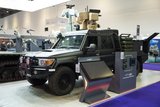Northrop Grumman doubles frequency of fastest reported integrated circuit
Northrop Grumman Corporation has set a new electronics performance record with a Terahertz Monolithic Integrated Circuit (TMIC) operating at 0.67 terahertz (THz), or 0.67 trillion cycles per second.
Developed at the company's Simon Ramo Microelectronics Center under a contract with the Defense Advanced Research Projects Agency's (DARPA) Terahertz Electronics program, this new performance record more than doubles the frequency of the fastest reported integrated circuit.
Dr. William Deal, THz Electronics program manager for Northrop Grumman's Aerospace Systems sector, detailed the performance of this new TMIC amplifier today at the Institute of Electrical and Electronics Engineers' (IEEE) International Microwave Symposium being held in Anaheim, Calif. He told fellow scientists that the TMIC amplifier is the first of its kind operating at 670 GHz.
"A variety of applications exist at these frequencies. These devices could double the bandwidth, or information carrying capacity, for future military communications networks. TMIC amplifiers will enable more sensitive radar and produce sensors with highly improved resolution," said Deal.
The goal of DARPA's Terahertz Electronics program is to develop the critical device and integration technologies necessary to realize compact, high-performance, electronic circuits that operate at center frequencies exceeding 1.0 THz. Managed by DARPA's Microsystems Technology Office, the program focuses on two areas – terahertz high-power amplifier modules, and terahertz transistor electronics.
"The success of the THz Electronics program will lead to revolutionary applications such as THz imaging systems, sub-mm-wave ultra-wideband ultra-high-capacity communication links, and sub-mm-wave single-chip widely-tunable synthesizers for explosive detection spectroscopy," according to Dr. John Albrecht, THz Electronics program manager for DARPA.
A transistor amplifier magnifies input signals to yield a significantly larger output signal. In 2007, Northrop Grumman set a new world record for transistor speed with an ultra-fast device to provide much higher frequency and bandwidth capabilities for future military communications, radar and intelligence applications.
The company produced and demonstrated an indium phosphide-based High Electron Mobility Transistor (InP HEMT) with a maximum frequency of operation of more than 1,000 gigahertz, or greater than one terahertz.
Source: Northrop Grumman
More from Digital Battlespace
-
![Babcock nears first customer for Nomad AI translation tool]()
Babcock nears first customer for Nomad AI translation tool
Nomad can provide militaries with real-time intelligence, saving critical time on the battlefield.
-
![AUSA 2025: Israel’s Asio Technologies to supply hundreds of improved Taurus tactical systems]()
AUSA 2025: Israel’s Asio Technologies to supply hundreds of improved Taurus tactical systems
Taurus operates alongside the Israel Defense Forces’ Orion system which supports mission management across tens of thousands of manoeuvring forces, from squad leaders to battalion commanders.
-
![AUSA 2025: Kopin pushes micro-LED plans as China moves faster]()
AUSA 2025: Kopin pushes micro-LED plans as China moves faster
The plan for the new displays follows fresh investment in Kopin’s European facilities by Theon and an order for head-up displays in fielded aircraft, with funding from the US Department of Defense.
-
![AUSA 2025: Persistent Systems to complete its largest order by year’s end]()
AUSA 2025: Persistent Systems to complete its largest order by year’s end
Persistent Systems received its largest ever single order for its MPU5 devices and other systems earlier this month and has already delivered the 50 units to the US Army’s 4th Infantry Division.
-
![Aselsan brings in dozens of companies and systems under the Steel Dome umbrella]()
Aselsan brings in dozens of companies and systems under the Steel Dome umbrella
Turkey has joined the family of countries attempting to establish a multilayered air defence system with government approval in August 2024 for the effort landed by Aselsan. Dubbed Steel Dome, the programme joins Israel’s Iron Dome, the US Golden Dome, India’s Mission Sudarshan Chakra and South Korea’s low-altitude missile defence system.
-
![DSEI 2025: MARSS unveils new agnostic multidomain C4 system]()
DSEI 2025: MARSS unveils new agnostic multidomain C4 system
MARSS’ NiDAR system has been deployed using sensors from static platforms to provide detection and protection for static sights, such as critical infrastructure, ports and military bases.




























